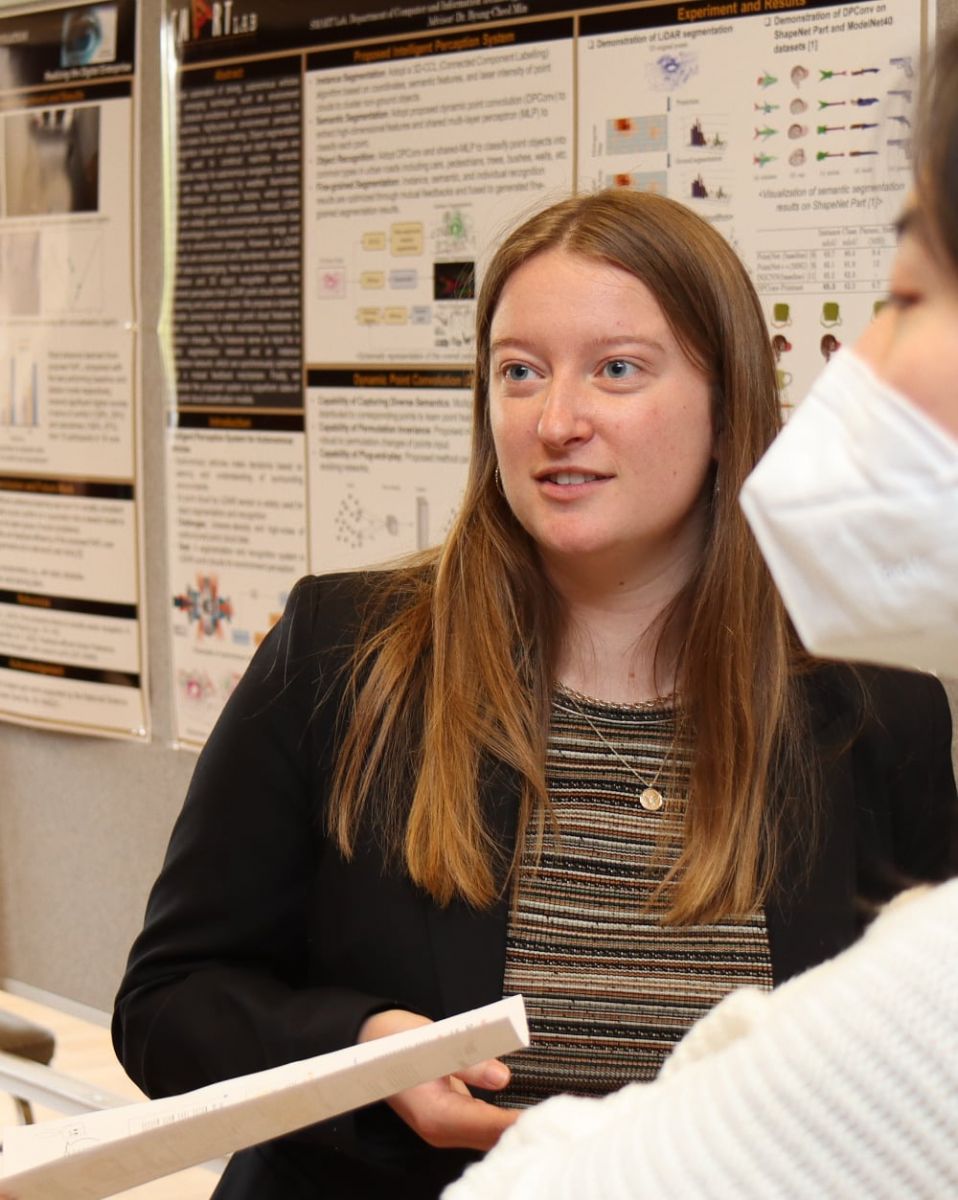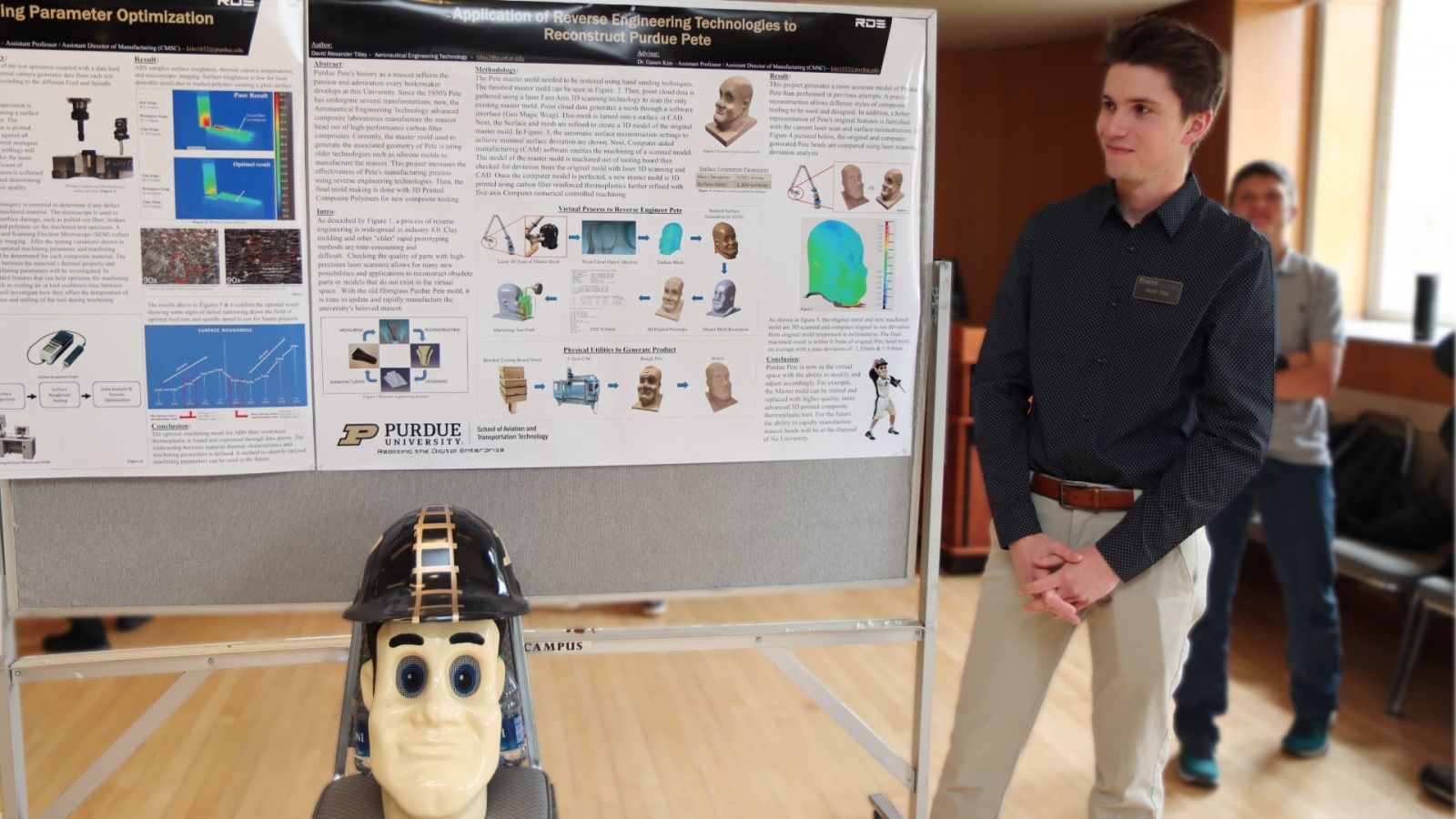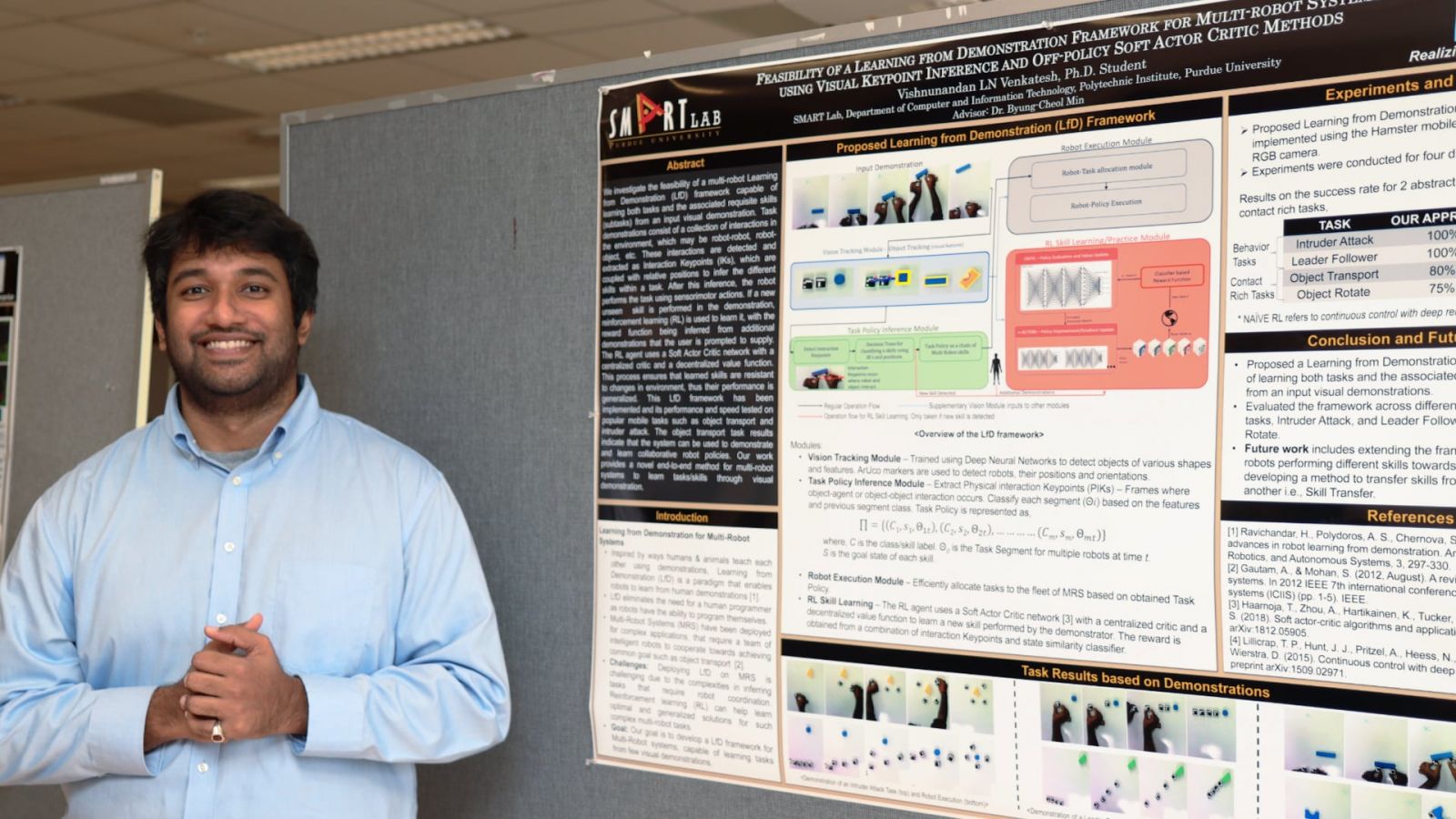 Undergraduate and graduate students in Purdue University’s Polytechnic Institute presented posters summarizing their 2021-2022 research projects at Stewart Center in late April.
Undergraduate and graduate students in Purdue University’s Polytechnic Institute presented posters summarizing their 2021-2022 research projects at Stewart Center in late April.
Students engaged in research affiliated with each of the Polytechnic’s strategic research impact areas (RIA), including Future Work and Learning, Holistic Safety and Security, and Realizing the Digital Enterprise. Titles and research abstracts for many of the Realizing the Digital Enterprise-affiliated projects are listed here; the remainder were listed in an earlier article.
Realizing the Digital Enterprise (part 2 of 2)
Ansh Shah, “Analysis of Human Mobility Change in Indiana During Covid-19 Pandemic”
Abstract: Analyzing the human mobility flow is essential for understanding the environmental and the socio-demographic implications of the covid-19 pandemic. Analyzing human mobility changes and recognizing spatial distribution patterns could also help us in tracking the spread of the virus from one particular location to another during a particular period of time and identifying a specific region’s adherence to regulating methods implemented by the governments.
In this study, we analyzed human mobility data in Indiana over 3 years from 2019 to 2021 with a focus on the changes before and during the covid-19 pandemic. Results show that human mobility generally decreased during the pandemic, but it varies from county to county.
Yujie Shan, “Reducing Lateral Stair-Stepping Defects in Liquid Crystal Display-Based Vat Photopolymerization by Defocusing the Image Pattern”
Abstract: Vat photopolymerization-based additive manufacturing (AM) technology has emerging success in efficiently fabricating complex and high-resolution objects. However, the lateral and vertical stair-stepping defects limit vat photopolymerization in manufacturing smooth surfaces, such as optical components. Vertical stair-stepping was mitigated by thinner layer thickness or layer-less fabrication. It is still challenging to reduce the lateral stair-stepping defects caused by the pixelated projection pattern, especially for Liquid Crystal Display (LCD) projection whose pixels are disconnected.
To tackle this lateral stair-stepping issue, we propose to defocus the curing image pattern by increasing the gap between the LCD screen and the resin vat. This gap intentionally blurs the disconnected pixels to create a continuous and smooth projection pattern. Experiments verified that the smoothened LCD pattern led to an average 81.2% reduction in surface roughness, which was much more effective than grayscale pixels. The gap between the LCD screen and the resin vat also enabled blowing air to dissipate the heat from the LCD and the resin polymerization, reducing the part distortion and printing failure due to thermal stress. The present approach improved the surface roughness and paved the way for vat photopolymerization in fabricating smooth micro-optics, microfluidic channels, and functional curved surfaces.
Xiaxin Shen, “Smart Monitoring and Detection of ECG and Breathing Sound Signals With Deep Learning”
Abstract: Signals like Electrocardiogram (ECG) and breathing sounds from medical sensors are critical for monitoring human health and identifying illness indications. Deep learning (DL) approaches with advances in signal processing show outstanding performances compared to traditional machine learning methods on anomaly detection tasks by achieving higher accuracy and performance.
In this paper, we propose a framework with convolutional neural network (CNN) to implement classification tasks for ECG and breathing sound signals. Wearable devices with sensors are used to collect the bio-signals. The signals are transformed into visuals to be fed to the DL models. The proposed system integrates DL and advanced signal processing for analyzing both ECG and breathing sound signals to detect the validity of the signals as well as medical anomalies accurately.

Roy Su, “Stretchable Fiber-Reinforced Elastomer Composite Using Wavy Patterned Fiber Reinforcement”
Abstract: The purpose of this study was to develop and demonstrate the manufacturing process of wavy patterned fiber-reinforced elastomer composites and investigate their behavior under tensile loading conditions. The wavy patterned fiber reinforcement were manufactured using a needle design jig and was tensile tested in accordance with ASTM D412. The test showed the specimen elongated until the fiber was straightened, then it hindered further elongation and increased the stiffness of the material. However, the fiber would slip out from the composite during the test. Therefore, further study is required to find better methods of containing the fiber in the composite without disbonding from the elastomer matrix.
Su Sun, “A Semantic Segmentation and 3D Object Recognition Approach for LiDAR Point Clouds”
Abstract: To realize automation of driving, autonomous vehicles employ emerging techniques such as environment sensing, obstacle avoidance, and autonomous control, in which real-time highly-precise environment perception provides a basis for decision making. Object segmentation and recognition based on videos and depth images are commonly used to construct real-time semantic environmental maps for autonomous navigation, but vision sensors are readily impacted by weather, illumination, surface reflection, and distance factors, which makes environment recognition results unstable.
Instead, LiDAR sensors are widely used in environmental perception due to their advantages in measurement precision, range, and invariance to environment changes. However, as LiDAR point clouds are unstructured and disordered, classification of LiDAR data is challenging. Here, we develop a semantic segmentation and 3D object recognition system for environment perception from LiDAR point clouds based on deep learning and computer vision.
We propose a dynamic deformable convolution to extract point cloud features in different receptive fields while maintaining invariance to permutation changes. The features serve as input for a semantic segmentation network and an instance segmentation network, which are synchronously optimized through a mutual feedback mechanism. Finally, we demonstrate the proposed system to outperform state-of-the-art point cloud classification models.
Senthilkumar Thiyagarajan, “Digital Supply Chain Use Cases: Digital Strategy for Metal Additive Manufacturing and Improving Resiliency via Digital Twin”
Abstract: This poster covers two use cases for digital supply chain: 1. Roadmap for adoption of metal additive manufacturing and 2. Framework for improvement of supply chain resilience through adoption of supply chain digital twin (Internet of Things and advanced analytics).
David Tilley, “Application of Reverse Engineering Technologies to Reconstruct Purdue Pete”
Abstract: Purdue Pete’s history as a mascot has contributed a great deal of pride and school spirit within the university. Since the 1950s, Pete has undergone several transformations. Now, the Aeronautical Engineering Technology advanced composites laboratories manufacture the mascot head out of high-performance carbon fiber composites. Currently, the master mold used to generate the associated geometry of Pete is using older technologies such as silicone molds to manufacture the mascot. This project increases the effectiveness of Pete's manufacturing process using reverse engineering technologies. Then, the final mold making is done with 3D-printed composite polymers for new composite tooling.
Vishnunandan Venkatesh, “Feasibility of a Learning from Demonstration Framework for Multi-robot Systems using Visual Keypoint Inference and Off-policy Soft Actor Critic Methods”
Abstract: We investigate the feasibility of a multi-robot Learning from Demonstration (LfD) framework capable of learning both tasks and the associated requisite skills (subtasks) from an input visual demonstration. Task demonstrations consist of a collection of interactions in the environment, which may be robot-robot, robot-object, etc. These interactions are detected and extracted as Interaction Keypoints (IKs), which are coupled with relative positions to infer the different skills within a task.
After this inference, the robot performs the task using sensorimotor actions. If a new unseen skill is performed in the demonstration, reinforcement learning (RL) is used to learn it, with the reward function being inferred from additional demonstrations that the user is prompted to supply. The RL agent uses a Soft Actor Critic network with a centralized critic and a decentralized value function.
This process ensures that learned skills are resistant to changes in environment, thus their performance is generalized. This LfD framework has been implemented and its performance and speed tested on popular mobile tasks such as object transport and intruder attack. The object transport task results indicate that the system can be used to demonstrate and learn collaborative robot policies. Our work provides a novel end-to-end method for multi-robot systems to learn tasks/skills through visual demonstration.

Ruiqi Wang, “Feedback-Efficient Preference Learning for Socially Compliant Robot Navigation”
Abstract: Socially compliant robot navigation, in which a robot adjusts its trajectory to maintain comfortable spatial interactions with humans while reaching its goal without collisions, is a vital yet challenging task in the context of human-robot interaction. While existing learning-based methods have achieved better performance than model-based ones, they still have drawbacks: namely, reinforcement learning relies on a handcrafted reward that is unlikely to effectively quantify broad social compliance and can lead to reward exploitation problems, and inverse reinforcement learning suffers from a requirement for expensive human demonstrations.
In this work, we present a feedback-efficient preference learning approach that distills human comfort and expectation into a reward model to guide a robot agent to explore latent aspects of social compliance. A hybrid experience learning module that includes curious exploration and expert demonstration is introduced to improve the efficiency of human feedback and samples. Extensive simulation experiments and a user study (N=10) involving navigation of a physical robot with human subjects in real-world scenarios both demonstrate our method to outperform existing state-of-the-art approaches, and to lead to more desirable and natural robot behaviors.
Mason Wilcox, “Application of 3D-Printed Water Soluble PVA Mold for Composite Part Manufacturing”
Abstract: Utilizing molds allows the fabrication of composites with positive draft angles with repeated results. However, molds increase the cost and manufacturing time for prototyping, while limiting the geometry to parts without negative draft angles. Given these challenges, additively manufactured sacrificial molds are introduced as a solution to traditional molds due to their limited geometry. The usage of printed molds is demonstrated by amalgamating and curing a composite part made from an aerospace grade composite prepreg material, AX-5201FR. Molds are additively manufactured using Fused Deposition Modeling (FDM) with Polyvinyl Alcohol (PVA).
Based on the results of a thermomechanical analysis of the PVA, a two-step curing cycle for manufacturing a composite part with AX-5201FR prepreg was designed. The part amalgamation achieved with this method was measured by analyzing the surface quality. The surface quality and low PVA residue achieved with the sacrificial mold method demonstrated the potential of this technology for providing sacrificial molds for prototyping.
Jared Vigar, “3D-Printed Thermoplastic Composite Machining Strategy and Parameter Optimization”
Abstract: 3D-printed fiber-reinforced composite is a new advanced material combining high-performance fiber reinforcement with a polymer matrix. Achieving an optimal machining parameter plays a crucial role in the surface quality of the workpiece and cutting tool life. Improper machining parameters cause surface defects such as fiber pull-out, breakage, and melted polymer. Thus, establishing optimal machining parameters for fiber-reinforced polymers while exploring the relationship between machining parameters and material thermal characteristics, including glass transition temperature, and melting temperature.
Tests concurrently lead to optimal feed rate and spindle speed associated with thermoplastics studied. The optimal result for each type of 3D-printed thermoplastic is yielded, including how the thermal performance of the polymer affects optimal machining parameters minimizing fiber breakage and tear out.
Fan Yang, “A Survey of Building Fire Simulation in the Architecture, Engineering, and Construction (AEC) Domains”
Abstract: Fire has been one of the main disasters of human society for centuries. Although professional practitioners and scholars have conducted a lot of research and experimental work on building fire simulation and related development, the trends for fire-related deaths and economic loss in the United States have increased in the past decade. On the other hand, the emergence of new building forms and the needs of special building functions expose building fire simulation to new challenges and problems. This paper provides a survey of the state-of-the-art works on building fire simulations by investigating the research that has been conducted in this field from 2015 to 2020. This review reveals that the fire simulation of high-rise and public buildings (e.g., subway stations and museums) has received more attention from researchers than others. This paper also summarizes the latest technological advances in this field. The results of this paper will help professional practitioners and scholars to identify challenges and problems to inform future studies.
Jiwei Zhou, “Case Study: A CNN-based Image Classification Approach to Measure Critical Bottle Dimensions”
Abstract: A local injection molding company is facing four significant challenges in the bottle measurement process: (1) high device investment, (2) high maintenance and technical support costs, (3) long operating time, and (4) requiring a quality inspector to have the professional knowledge to operate. The research goal is to develop a system to maintain a similar measurement precision (0.001 inch) as its current measuring device, reduce the company’s costs, increase bottle inspection productivity, and make it easy to operate during the measurement process.
The poster presents an object dimension measurement approach based on Convolutional Neural Network (CNN) and computer vision to perform non-contact measurements of medicine bottles' critical dimensions, such as bead height, neck diameter:
1. A new camera measuring stand is designed to hold three cameras to capture images from the bottle.
2. Four relevant image areas are cropped and labeled to map the critical bottle dimensions for the CNN model training, validation, and testing.
3. The predicted dimensions are compared with the actual measurements to evaluate and improve the model performance.
The research project is in progress, and the proposed approach is expected to achieve an average of 95% accuracy in predicting measurement values and shorten 90% operating time.
Additional information
- Student researchers present Realizing the Digital Enterprise projects at spring poster session (1 of 2)
- Student researchers present Future Work and Learning projects at spring poster session
- Student researchers present Holistic Safety and Security projects at spring poster session
- Purdue Polytechnic’s Strategic Research Impact Areas
- Purdue Polytechnic Office of Research
- Purdue Polytechnic’s Holistic Safety and Security research projects receive national attention, funding
- Future Work and Learning research projects focus on all human-technology interactions
- Realizing the Digital Enterprise researchers pair technology, social responsibility
- Undergraduate researchers present projects at fall expo
